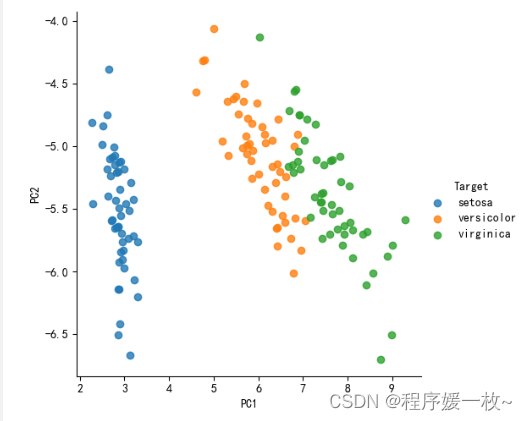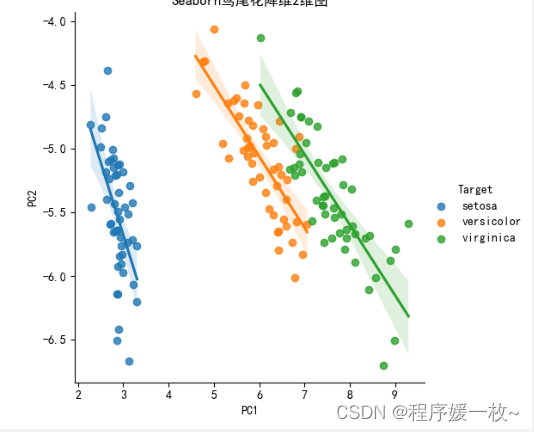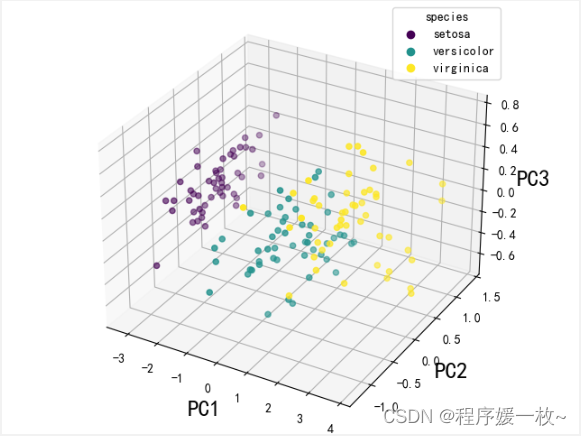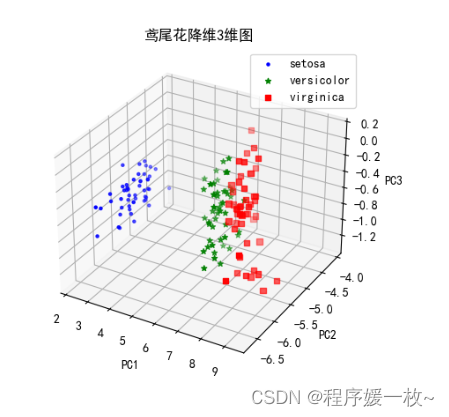这篇博客将介绍如何使用Python,PCA对iris数据集降维2,3并进行2D,3D散点图绘制(包括有图例&无图例,有标题Label&无标题Label)。
着重介绍怎么一次性添加多类型的图例到图表,通过显式获取scatter。
# 方法1
scatter = ax.scatter(x_reduced[:, 0], x_reduced[:, 1], x_reduced[:, 2], c=iris.target)
# 方法2
scatter = plt.scatter(x_reduced[:, 0], x_reduced[:, 1], c=iris.target, marker="d")
# 添加图例名称到图标
plt.legend(handles=scatter.legend_elements()[0],
labels=sp_names,
title="species", loc="upper right")
1. 效果图
对鸢尾花进行PCA降维成2维后进行绘制,Seaborn效果图如下:

对鸢尾花进行PCA降维成2维后进行绘制,Seaborn添加标题及散点拟合线 效果图如下:

对鸢尾花进行PCA降维成3维后进行绘制,Matplotlib3D效果图如下:

对鸢尾花进行PCA降维成3维简单绘制效果图如下:

对鸢尾花进行PCA降维成3维后进行绘制,添加中文标题,xyz轴描述及图例,不同类型用不同的样式mark 效果图如下:

2. 源码
# 使用PCA对鸢尾花特征进行降维2维/3维并绘制 2D,3D散点图(有图例&无图例,有标题Lable&无标题Lable)
# python iris_pca.py
import matplotlib.pyplot as plt
import numpy as np
import pandas as pd
import seaborn as sns
from mpl_toolkits.mplot3d import Axes3D
from sklearn import datasets
from sklearn.decomposition import PCA
# 支持中文
plt.rcParams['font.sans-serif'] = ['SimHei']
plt.rcParams['axes.unicode_minus'] = False
iris = datasets.load_iris()
R = np.array(iris.data)
R_cov = np.cov(R, rowvar=False)
iris_covmat = pd.DataFrame(data=R_cov, columns=iris.feature_names)
iris_covmat.index = iris.feature_names
eig_values, eig_vectors = np.linalg.eig(R_cov)
def plot_2D_Seaborn():
featureVector = eig_vectors[:, :2]
featureVector_t = np.transpose(featureVector)
# R is the original iris dataset
R_t = np.transpose(R)
newDataset_t = np.matmul(featureVector_t, R_t)
newDataset = np.transpose(newDataset_t)
# 可视化 绘制2D图
# 鸢尾花数据创建dataframe
df = pd.DataFrame(data=newDataset, columns=['PC1', 'PC2'])
y = pd.Series(iris.target)
y = y.replace(0, 'setosa')
y = y.replace(1, 'versicolor')
y = y.replace(2, 'virginica')
df['Target'] = y
# 绘制2维数据,fit_reg是否拟合线
sns.lmplot(x='PC1', y='PC2', data=df, hue='Target', fit_reg=False, legend=True)
# sns.lmplot(x='PC1', y='PC2', data=df, hue='Target', fit_reg=True, legend=True)
plt.title("Seaborn鸢尾花降维2维图") # 会被截取不全
plt.show()
# PCA降2维
# 无图例 & 有图例
def plot_2D_PCA_Legend():
# 进行PCA降维
x_reduced = PCA(n_components=2).fit_transform(iris.data)
y = pd.Series(iris.target)
y = y.replace(0, 'setosa')
y = y.replace(1, 'versicolor')
y = y.replace(2, 'virginica')
fig = plt.figure()
ax = fig.add_subplot()
# 2D散点图无图例
ax.scatter(x_reduced[:, 0], x_reduced[:, 1], c=iris.target, marker="d")
plt.show()
print(np.unique(np.array(y)).tolist())
print(np.unique(iris.target).tolist())
# ax.legend(np.unique(iris.target).tolist())
# ax.legend(np.unique(np.array(y)).tolist(),loc='upper right')
# 2D散点图有标题,label,图例
plt.figure(figsize=(8, 6))
sp_names = np.unique(np.array(y)).tolist()
scatter = plt.scatter(x_reduced[:, 0], x_reduced[:, 1], c=iris.target, marker="d")
plt.title('鸢尾花降维2维图')
plt.xlabel("PC1", size=18)
plt.ylabel("PC2", size=18)
# 添加图例名称到图标
plt.legend(handles=scatter.legend_elements()[0],
labels=sp_names,
title="species", loc="upper right")
plt.show()
# PCA降3维
# 无图例 & 有图例
def plot_3D_PCA_Legend():
# 进行PCA降维
x_reduced = PCA(n_components=3).fit_transform(iris.data)
y = pd.Series(iris.target)
y = y.replace(0, 'setosa')
y = y.replace(1, 'versicolor')
y = y.replace(2, 'virginica')
fig = plt.figure()
ax = Axes3D(fig)
# 3D散点图无图例
ax.scatter(x_reduced[:, 0], x_reduced[:, 1], x_reduced[:, 2], c=iris.target)
plt.show()
sp_names = np.unique(np.array(y)).tolist()
fig = plt.figure()
ax = Axes3D(fig)
# 3D散点图有标题,label,图例
scatter = ax.scatter(x_reduced[:, 0], x_reduced[:, 1], x_reduced[:, 2], c=iris.target)
ax.set_title('鸢尾花降维3维图')
ax.set_xlabel("PC1", size=18)
ax.set_ylabel("PC2", size=18)
ax.set_zlabel("PC3", size=18)
# 添加图例名称到图标
ax.legend(handles=scatter.legend_elements()[0],
labels=sp_names,
title="species", loc="upper right")
plt.show()
# 不同的PCA降维
def plot_3D():
featureVector = eig_vectors[:, :3]
featureVector_t = np.transpose(featureVector)
# R is the original iris dataset
R_t = np.transpose(R)
newDataset_t = np.matmul(featureVector_t, R_t)
newDataset = np.transpose(newDataset_t)
# 构建DataFrame
df = pd.DataFrame(data=newDataset, columns=['PC1', 'PC2', 'PC3'])
y = pd.Series(iris.target)
y = y.replace(0, 'setosa')
y = y.replace(1, 'versicolor')
y = y.replace(2, 'virginica')
df['Target'] = y
# print(df.head(5))
# 根据其中一列分组
df = df.groupby("Target")
# print(df.groups) # key
# print(df.get_group('setosa')) # 某个value
# matplot支持的点样式及点颜色
marks = ['.', '*', 's', ',', 'o', 'v', '^', '<', '>', '1', '2', '3', '4', '8', 'p', 'P', 'h', 'H', '+', 'x', 'X',
'D', 'd', '|', '_']
colors = ['b', 'g', 'r', 'c', 'm', 'y', 'k', 'w']
fig = plt.figure()
ax = fig.add_subplot(projection='3d')
ax.set_title('鸢尾花降维3维图')
for i, key in enumerate(df.groups.keys()):
val = df.get_group(key)
ax.scatter(val["PC1"], val["PC2"], val["PC3"], c=colors[i % len(colors)], marker=marks[i % len(marks)],
label=key)
ax.set_xlabel('PC1')
ax.set_ylabel('PC2')
ax.set_zlabel('PC3')
ax.legend(loc='upper right')
plt.show()
plot_2D_Seaborn()
plot_2D_PCA_Legend()
plot_3D_PCA_Legend()
plot_3D()








 本文介绍使用Python和PCA技术对鸢尾花数据集进行2D和3D降维,并展示如何利用Matplotlib和Seaborn绘制带有图例和标题的散点图。此外,还详细说明了如何添加不同类型的图例到图表中。
本文介绍使用Python和PCA技术对鸢尾花数据集进行2D和3D降维,并展示如何利用Matplotlib和Seaborn绘制带有图例和标题的散点图。此外,还详细说明了如何添加不同类型的图例到图表中。


















 2万+
2万+

 被折叠的 条评论
为什么被折叠?
被折叠的 条评论
为什么被折叠?










